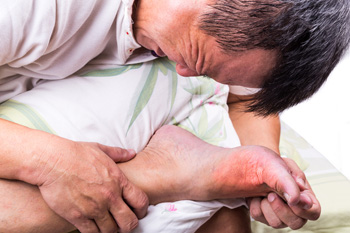Connect With Us
Blog
Items filtered by date: July 2023
How the Feet Can Be Impacted by Obesity

Research indicates that approximately one-third of the American population is obese. The feet can be impacted when extra weight is placed on them, and various foot conditions can develop. Obesity can cause the misalignment of various areas in the body, and the feet can feel the brunt of this. It is said that one pound of weight can increase the pressure on the feet and ankles by as much as eight pounds. This can become uncomfortable as the weight increases and may worsen while walking up the steps. A common foot condition that can occur from being obese is overpronation. This is described as the foot rolling inward while walking, which can result from flattened arches. Stress on the joints in the feet may evolve into osteoarthritis caused by excessive wear and tear. The chances of losing weight are increased when a gentle exercise routine is frequently followed. If you have questions about any foot pain you may be experiencing with weight gain, it is suggested that you confer with a podiatrist who can guide you toward a healthier lifestyle.
The more you weigh, the harder your feet must work to support your body. If you’re an obese individual and are concerned about your feet, contact Dr. John R. Northrup from Superior Foot, Ankle & Wound Care. Our doctors can provide the care you need to keep you pain-free and on your feet.
Obesity and Your Feet
People who are overweight are putting more pressure on their ankles, knees, and hips as well as their feet. This unfortunately can lead to variety of different issues.
Problems & Complications Stemming from Obesity
- When the body is overweight, it tries to compensate by changing the way that it moves. An obese person may lean forward and put extra weight on the wrong part of the foot. This puts unnecessary stress on the feet.
- Obese people are also more likely to develop type II diabetes which is a condition that causes a lot of foot problems. People with diabetes often don’t feel the cuts and sores that they may have on their feet, which can lead to more complicated and severe issues.
- Plantar fasciitis is another foot condition that can be caused by obesity. Plantar fasciitis is an inflammation of the tissue along the bottom of the foot, which causes pain and stiffness while walking and climbing stairs.
If you have any questions, please feel free to contact one of our offices located in St. Augustine, and Palm Coast, FL . We offer the newest diagnostic and treatment technologies for all your foot care needs.
Causes of Gout

Gout is a painful form of arthritis that commonly affects a joint in the big toe, but also occurs in other joints of the body. Attacks of gout, called flare-ups, come on suddenly and frequently occur during sleeping hours. They are characterized by redness, swelling, heat, and constant pain. Gout is mainly caused by an overabundance of uric acid, which is formed during the breakdown of purines in the system. Eating foods that contain high levels of purines, including red meats, seafood, alcohol, and sugary drinks, can set off gout attacks. Crystals of uric acid can build up in the joints, resulting in inflammation and severe pain. Gout may be associated with kidney disease, obesity, and heart disease, as well as from a hereditary disposition. While it is not curable, there are ways to manage it and lower the risk of experiencing gout. It is important to control gout as recurring attacks can damage joints and tendons. Reducing the amount of uric acid is the number one way to treat gout. Certain medications, such as colchicine and non-steroidal anti-inflammatories, can help to reduce the effects of gout. For more information about gout treatments, it is suggested that you make an appointment with a podiatrist.
Gout is a painful condition that can be treated. If you are seeking treatment, contact Dr. John R. Northrup from Superior Foot, Ankle & Wound Care. Our doctors will treat your foot and ankle needs.
What Is Gout?
Gout is a form of arthritis that is characterized by sudden, severe attacks of pain, redness, and tenderness in the joints. The condition usually affects the joint at the base of the big toe. A gout attack can occur at any random time, such as the middle of the night while you are asleep.
Symptoms
- Intense Joint Pain - Usually around the large joint of your big toe, and it most severe within the first four to twelve hours
- Lingering Discomfort - Joint discomfort may last from a few days to a few weeks
- Inflammation and Redness -Affected joints may become swollen, tender, warm and red
- Limited Range of Motion - May experience a decrease in joint mobility
Risk Factors
- Genetics - If family members have gout, you’re more likely to have it
- Medications - Diuretic medications can raise uric acid levels
- Gender/Age - Gout is more common in men until the age of 60. It is believed that estrogen protects women until that point
- Diet - Eating red meat and shellfish increases your risk
- Alcohol - Having more than two alcoholic drinks per day increases your risk
- Obesity - Obese people are at a higher risk for gout
Prior to visiting your podiatrist to receive treatment for gout, there are a few things you should do beforehand. If you have gout you should write down your symptoms--including when they started and how often you experience them, important medical information you may have, and any questions you may have. Writing down these three things will help your podiatrist in assessing your specific situation so that he or she may provide the best route of treatment for you.
If you have any questions, please feel free to contact one of our offices located in St. Augustine, and Palm Coast, FL . We offer the newest diagnostic and treatment technologies for all your foot care needs.
Symptoms of Sever’s Disease

Sever’s disease is a condition that affects the heels in active children and young teenagers. Participating in running and jumping sporting events may cause Sever’s disease, as a result of, pressure on the heel. Sever’s disease is named after the American doctor James Sever, who discovered this condition in 1912. The heel pain that happens with Sever's disease generally occurs during a growth spurt and may be accompanied by swollen feet. Parents may notice their child is limping or walking on their tiptoes, and this can indicate Sever’s disease. Relief can begin with temporarily stopping the activity that caused this condition, in addition to frequently elevating the foot. As the affected foot heals, there may be specific stretches that can be done that can strengthen the heel. If your child has heel pain, it is strongly suggested that you consult with a podiatrist who can effectively treat Sever’s disease.
Sever's disease often occurs in children and teens. If your child is experiencing foot or ankle pain, see Dr. John R. Northrup from Superior Foot, Ankle & Wound Care. Our doctors can treat your child’s foot and ankle needs.
Sever’s Disease
Sever’s disease is also known as calcaneal apophysitis, which is a medical condition that causes heel pain I none or both feet. The disease is known to affect children between the ages of 8 and 14.
Sever’s disease occurs when part of the child’s heel known as the growth plate (calcaneal epiphysis) is attached to the Achilles tendon. This area can suffer injury when the muscles and tendons of the growing foot do not keep pace with bone growth. Therefore, the constant pain which one experiences at the back of the heel will make the child unable to put any weight on the heel. The child is then forced to walk on their toes.
Symptoms
Acute pain – Pain associated with Sever’s disease is usually felt in the heel when the child engages in physical activity such as walking, jumping and or running.
Highly active – Children who are very active are among the most susceptible in experiencing Sever’s disease, because of the stress and tension placed on their feet.
If you have any questions, please feel free to contact one of our offices located in St. Augustine, and Palm Coast, FL . We offer the newest diagnostic and treatment technologies for all your foot and ankle injuries.
Facts About Bone Spurs on the Feet

Bone spurs can form on any joint, but the feet are a common location, especially for patients who are 60 years old or above. The reason for this is that bone spurs, medically known as osteophytes, generally take years to grow. They are most often found on the ankle, heel, or big toe. Bone spurs form when bones rub against each other, which is generally the result of wear and tear of a joint, combined with the loss of the cartilage that separates the bones. People with osteoarthritis frequently develop bone spurs. Young athletes may develop bone spurs from injuries that occur during sports. Symptoms of a bone spur include aching pain that worsens with activity, swelling, tingling and numbness, or stiffness. In many cases, however, bone spurs may form without displaying any symptoms at all. An X-ray is thought to be the best way to determine if you have a bone spur. Treatment for bone spurs may include wearing protective padding in the shoes, having cortisone injections, losing weight, and doing certain foot exercises. In some cases, surgery may be a remedy. For more information on how to deal with bone spurs, it is suggested that you visit a podiatrist.
Foot Pain
Foot pain can be extremely painful and debilitating. If you have a foot pain, consult with Dr. John R. Northrup from Superior Foot, Ankle & Wound Care. Our doctors will assess your condition and provide you with quality foot and ankle treatment.
Causes
Foot pain is a very broad condition that could be caused by one or more ailments. The most common include:
- Bunions
- Hammertoes
- Plantar Fasciitis
- Bone Spurs
- Corns
- Tarsal Tunnel Syndrome
- Ingrown Toenails
- Arthritis (such as Gout, Rheumatoid, and Osteoarthritis)
- Flat Feet
- Injury (from stress fractures, broken toe, foot, ankle, Achilles tendon ruptures, and sprains)
- And more
Diagnosis
To figure out the cause of foot pain, podiatrists utilize several different methods. This can range from simple visual inspections and sensation tests to X-rays and MRI scans. Prior medical history, family medical history, and any recent physical traumatic events will all be taken into consideration for a proper diagnosis.
Treatment
Treatment depends upon the cause of the foot pain. Whether it is resting, staying off the foot, or having surgery; podiatrists have a number of treatment options available for foot pain.
If you have any questions, please feel free to contact one of our offices located in St. Augustine, and Palm Coast, FL . We offer the newest diagnostic and treatment technologies for all your foot care needs.

